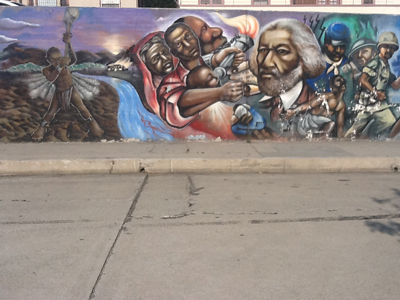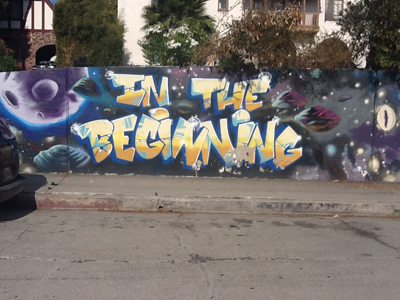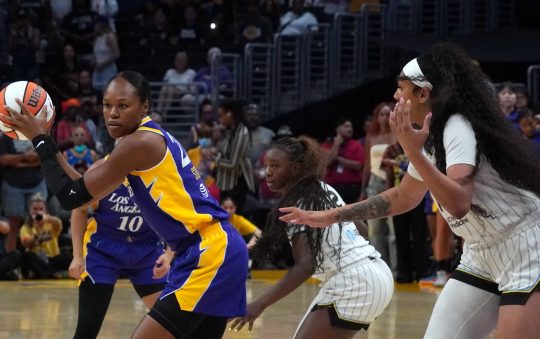
Crenshaw Mural
Along Crenshaw Boulevard, from 50th to approximately 52nd , is the Crenshaw Mural of African-American Progress.
The Crenshaw Mural is located within a district empowered by influential African-American pioneers, enriched by several natives and organizations, in an area with a history of revolution. From acts associated with The Uprising to the housing of former Olympians, Crenshaw Boulevard and District possess a lineage of tragedy and triumph. Appropriately included within the mural are figures that impacted American history as well as African-American culture. With voices lifted and differences made, from Frederick Douglass to Haile Selassie, the images of these pioneers represent their legacy and deserved exaltation in reverence of their dedication and advocacy.
Introduced by the phrase, “In the Beginning”, orator and former slave, Frederick Douglass commences the group of leaders featured in the wall painting. Standing as an example of intelligence and aptitude, disproving the claims of slave-owners, Frederick Douglass lead the abolitionist movement. Having produced several autobiographical works, Douglass believed in unity amongst all: Black, White, man or woman. The self-taught genius symbolizes intellect, tenacity and a love of people. His life is a testament to perseverance and the will to survive. Similarly faithful in the movement of uplifting African Americans was the multi-talented journalist, political leader and orator Marcus Garvey. Considered a supporter of Black Nationalism, Garvey also fueled the beliefs associated with Pan-Africanism.
Garvey revealed in his editorial(s) his promotion of Pan-Africanism, for Blacks to solely reunite in Africa. Participating in several political movements, the Jamaican leader founded their first political party (the PPP, People’s Political Party) in addition to presenting the Petition of the Negro Race which outlined the abuse of African descendants. Later in his life, Garvey collaborated with White American and then U.S. Senator Bilbo, creating a repatriation scheme. Named in the ‘religious prophet’s’ honor are several highways, buildings and schools, such as Los Angeles’s very own, local Marcus Garvey Elementary School. Achieving similar notable success, was the distinguished, former MFL star Jim Brown. While his accomplishments took place both on and off the field, his athleticism was attributed to a fiery passion which fueled much of the Black community’s admiration.
Best known for his running back career with the Cleveland Browns, from the year 1957 to 1965, Brown is considered one of the best football players of all time. With involvement in other athletics such as baseball and lacrosse, Brown was acknowledged for his athleticism as well as impeccable statistics. Considered among the first to catapult from the football field into other endeavors (and successfully), Brown made appearances in several films such as Rio Conchos, 100 Rifles and Any Given Sunday. Following his retirement, Brown is still recognized as being one of the greatest football players of all time. With such dedication, it’s no wonder that Brown is amongst the best of leaders to impact the Black community. As Brown surpassed the prejudices experienced along his athletic journey, in the same way, Ethiopian emperor Haile Selassi made progress in terminating social injustice.
Often identified with ‘The Lion’, Selassi influenced many other leaders such as Nelson Mandela, Malcolm X and Martin Luther King Jr. As a prominent figure in Ethiopian and African history, Selassie was an integral part in the intergovernmental organization of the League of Nations. By way of his advocacy for internationalism, Ethiopia was deemed a participant in the United Nations, promoting ‘collective security’, etc. Deemed by Rastafari followers as the returned Messiah and God incarnate, Selassi’s emperorship was controversial. While many disagreed with his values and methods, he stood by them which in part positively impacted the country of Ethiopia, carrying on throughout other establishments affected by his successors.
All of the figures mentioned above have impacted African culture, African-American culture, and/or American history in one way or another. They are amongst several other leaders featured on the Crenshaw Mural of African American Progress, on Crenshaw Boulevard in the Crenshaw District. While Crenshaw has witnessed some tragic days due to crime, violence and injustice, it’s the image of this wall painting that inspires a better tomorrow. Because of the legacy incorporated, the future of our community can shine bright. So the next time you’re in passing, take a look and remember the pioneers that inspired African-American Progress.

Photos by Ashley Nash, Sentinel Intern






